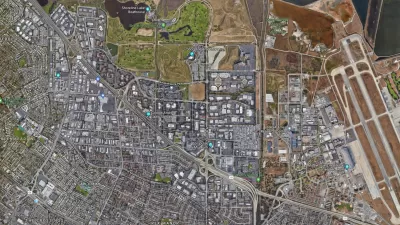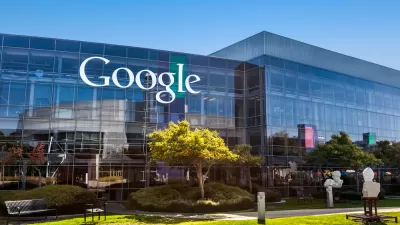Fast Company details the ambitions of a plan that would add thousands of homes, open space, and commercial development to the home of Google in the Silicon Valley.

Adele Peters reports on Google's plans to transform its headquarters in Mountain View, California—currently the stereotypical picture of a suburban corporate campus—into a walkable, liveable neighborhood.
[T]he designers working with Google on the redesign hope that it can become a model for turning other pavement-filled suburbs into green spaces where people are less likely to drive," according to Peters.
In addition to 5,700 new homes, "[t]he plan calls for 3.12 million square feet of office space and as much as 400,000 square feet of new retail space along with the homes," according to Peters. "Twenty percent of the housing will be affordable. It’s a response to a plan passed by the city in 2017 that rezoned the area, called the North Bayshore district..."
According to Laura Crescimano, quoted in the article as the founder of Sitelab Urban Studio, the urban design and strategy firm that led the creation of a proposed plan, the plan attempts to address the region's housing shortage as well as reducing car trips.
FULL STORY: Google’s new housing development will get suburban workers out of their cars

Planetizen Federal Action Tracker
A weekly monitor of how Trump’s orders and actions are impacting planners and planning in America.

Congressman Proposes Bill to Rename DC Metro “Trump Train”
The Make Autorail Great Again Act would withhold federal funding to the system until the Washington Metropolitan Area Transit Authority (WMATA), rebrands as the Washington Metropolitan Authority for Greater Access (WMAGA).

DARTSpace Platform Streamlines Dallas TOD Application Process
The Dallas transit agency hopes a shorter permitting timeline will boost transit-oriented development around rail stations.

Renters Now Outnumber Homeowners in Over 200 US Suburbs
High housing costs in city centers and the new-found flexibility offered by remote work are pushing more renters to suburban areas.

The Tiny, Adorable $7,000 Car Turning Japan Onto EVs
The single seat Mibot charges from a regular plug as quickly as an iPad, and is about half the price of an average EV.

Supreme Court Ruling in Pipeline Case Guts Federal Environmental Law
The decision limits the scope of a federal law that mandates extensive environmental impact reviews of energy, infrastructure, and transportation projects.
Urban Design for Planners 1: Software Tools
This six-course series explores essential urban design concepts using open source software and equips planners with the tools they need to participate fully in the urban design process.
Planning for Universal Design
Learn the tools for implementing Universal Design in planning regulations.
Municipality of Princeton
Roanoke Valley-Alleghany Regional Commission
City of Mt Shasta
City of Camden Redevelopment Agency
City of Astoria
Transportation Research & Education Center (TREC) at Portland State University
US High Speed Rail Association
City of Camden Redevelopment Agency
Municipality of Princeton (NJ)




























